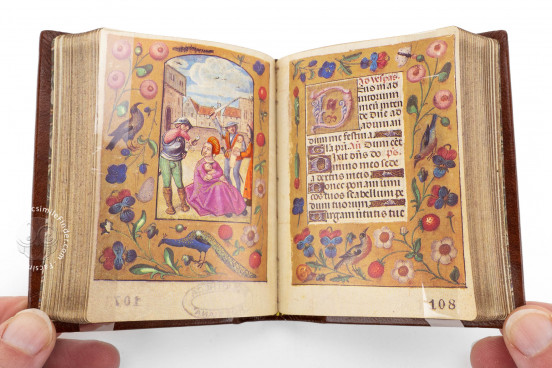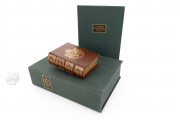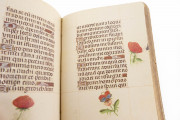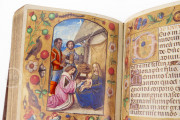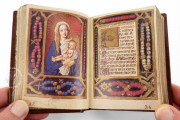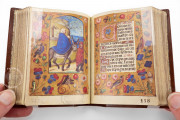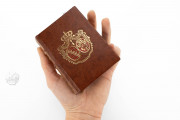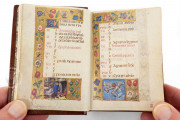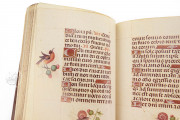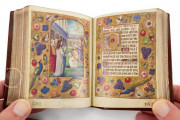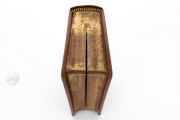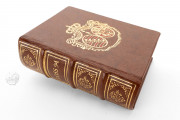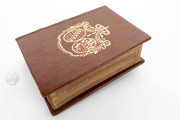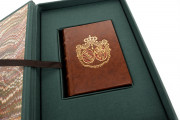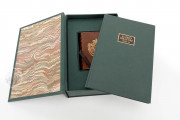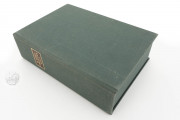The Book of Hours from Bruges is an exquisite example of Bruges illumination. Dating from around 1500 and small enough to be held in one hand, the book would have been consulted in the private prayers of a Christian believer. In addition to its decorated calendar, the book is illuminated with fifteen full-page miniatures and sixteen full borders, in addition to one historiated initial, twenty-four calendar pages with three-quarter painted borders, and countless marginal vignettes.
Preserved in an elegant modern binding, the manuscript begins with a calendar decorated with the signs of the zodiac and labors of the months in three-quarter floral borders. The text proper opens with a prayer to the Holy Face introduced by an image of the Salvator Mundi (fol. 14v) and continues with a series of Latin devotional texts centered around the Hours of the Virgin typically gathered in a book of hours.
Framed in Florals
Each major section of the manuscript originally opened with a full-page miniature situated on the left page of a two-page spread with fully painted borders that harmonized across the opening. Fifteen of an original sixteen of these sumptuous openings survive in their entirety.
Most of the borders are of the renowned Ghent-Bruges strewn-flower type, with flowers and creatures that appear as if in the reader's space poised atop and casting shadows on the surface of the page. While flowers—some potted—dominate these borders, interspersed are insects, snails, birds, and drolleries that take the form of amusing hybrid figures. Departing from the dominant theme, the opening of the votive mass for the Virgin (fols. 33v-34r) features colorful bejeweled rosaries set into the compartments of fictive carved wood frames.
Embellished Text
The text is written in the Gothic Rotunda script employed by Bruges scribes producing devotional books for export. The major textual divisions are signaled by large decorated initials, and the text is punctuated by a multitude of smaller decorated initials and elegant line-fillers.
The ample margins of the text pages without fully painted borders are decorated with vignettes of flowers, fruits, gems, jewelry, birds, insects, and drolleries. These marginal motifs of astonishing variety over the course of the book's pages are carefully harmonized across each opening.
Made for an Anonymous Patron
The manuscript offers no coat of arms, personalized prayers, or additions to the calendar that might serve as clues to ownership. Its extensive high-quality illumination indicates that it must have been commissioned or purchased by someone of considerable means. The manuscript was deposited in the Biblioteca Apostolica by the Society of Jesus in 1921 from the library of Giovanni Francesco De Rossi (1796-1854).
We have 1 facsimile edition of the manuscript "Book of Hours from Bruges": Stundenbuch aus Brügge facsimile edition, published by Belser Verlag, 1984
Request Info / Price
